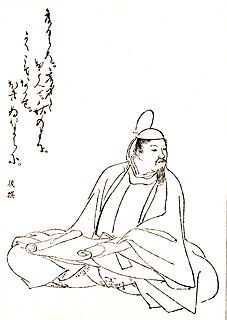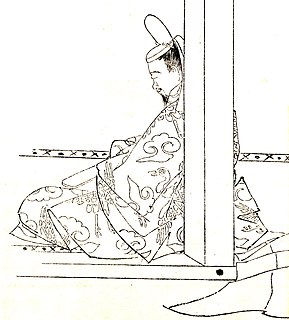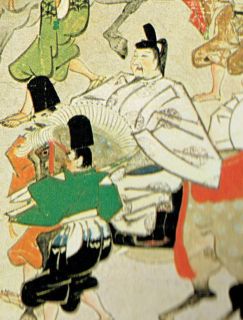
Emperor Uda was the 59th emperor of Japan, according to the traditional order of succession.

Fujiwara clan, descending from the Nakatomi clan and through them Ame-no-Koyane-no-Mikoto, was a powerful family of regents in Japan.
Emperor Go-Suzaku was the 69th emperor of Japan, according to the traditional order of succession.
Emperor Go-Reizei was the 70th emperor of Japan, according to the traditional order of succession.

Emperor Go-Sanjō was the 71st emperor of Japan, according to the traditional order of succession.
Emperor Horikawa was the 73rd emperor of Japan, according to the traditional order of succession.
Emperor Reizei was the 63rd emperor of Japan, according to the traditional order of succession.

Emperor Ichijō was the 66th emperor of Japan, according to the traditional order of succession.

Fujiwara no Morosuke, also known as Kujō-dono or Bōjō-udaijin, was a Japanese statesman, courtier and politician during the middle Heian period. Considered a learned scholar and well-versed in the customs of the court, he supported the court's government as udaijin during the reign of Emperor Murakami. Morosuke's eldest daughter Fujiwara no Anshi, empress consort to Emperor Murakami, gave birth to two princes who later became Emperor Reizei and Emperor En'yū, putting Morosuke's lineage in an advantageous position as the maternal relatives of the Emperor.
Fujiwara no Yoritada, the second son of Saneyori, was a kugyo who served as regent for Emperor En'yū and Emperor Kazan. His mother was a daughter of Fujiwara no Tokihira. His elder brother from the same mother Atsutoshi died before their father's death.

Fujiwara no Kaneie was a Japanese statesman, courtier and politician during the Heian period.

Anna (安和) was a Japanese era after Kōhō and before Tenroku. This period spanned the years from August 968 through March 970. The reigning emperors were Reizei-tennō (冷泉天皇) and En'yū-tennō (円融天皇).

Fujiwara no Sanesuke, also known as Go-Ono no Miya (後小野宮), was fourth son of Fujiwara no Tadatoshi. He became udaijin in 1021, and lived to be ninety. He became adopted heir of his grandfather Saneyori, the head of Ononomiya family (小野宮家), and he inherited vast estate and documents of Ononomiya family. Sanesuke had a thorough knowledge of customs and rites, so he was called Kenjin Ufu (賢人右府). He wrote the diary Shōyūki (小右記) for fifty years.

Fujiwara no Sukemasa was a Japanese noble, statesman, and renowned calligrapher of the middle Heian period. Grandson and adopted son of the daijō-daijin Fujiwara no Saneyori and son of major general of the imperial guard Fujiwara no Atsutoshi (藤原敦敏), he is honored as one of the Sanseki, a group of outstanding calligraphers.
Fujiwara no Yoshikane (957–1021) was a Japanese Heian era courtier. A son of Fujiwara no Koretada, he served under Emperor Kazan before joining his brother Korenari, and the Emperor in becoming monks, in 986. He also prevented the Emperor from committing suicide following the death of his wife Tsune-ko.

Minamoto no Mitsunaka, was born as Myoomaru (明王丸) son of Minamoto no Tsunemoto, was a samurai and Court official of Japan's Heian period. Mitsunaka belonged to the Seiwa Genji branch of the Minamoto clan, which traced its ancestry to Emperor Seiwa. He loyally served several successive Fujiwara regents beginning with Fujiwara no Morotada. Mitsunaka allied himself with Morotada in 969, by implicating Minamoto no Takaakira—Morotada's major political rival—in a plot against the throne. It is not clear whether these accusations were true, but Takaakira was sent into exile, placing Mitsunaka firmly in Morotada's good graces. Later, Mitsunaka would assist Fujiwara no Kaneie in his plot to coerce Emperor Kazan into taking Buddhist vows and abdicating in favor of Fujiwara's seven-year-old grandson.

Fujiwara no Korechika, the second son of Michitaka, was a kugyo of the Heian period. His mother was Takashina no Takako, also known as Kō-no-Naishi (高内侍). His sister Teishi (Sadako) was married to Emperor Ichijō, and Korechika aspired to become the regent (Sessho) for his young brother-in-law after his father's death. Korechika's ambitions pitted him against his powerful uncle, Fujiwara no Michinaga, and the resulting power struggle continued until Empress Teishi's unexpected death. This left Michinaga's daughter, Shoshi, as Ichijō's sole empress, solidifying Michinaga's power at court.
Fujiwara no Tamemitsu (942–992) was a Japanese statesman, courtier and politician during the Heian period.











